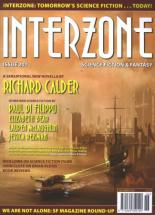
"Harsh Oases" by Paul Di Filippo
"Sheila" by Lauren McLaughlin
"Boy Twelve" by Jessica Reisman
"Wax" by Elizabeth Bear
But, how about the stories? Do they match up with the shiny design?
First story up is Paul Di Filippo‘s "Harsh Oases." I have to think that Di Filippo had fun while writing this story; it’s certainly a delight to read. Di Filippo creates a world where genes are sartorized rather than tailored, tribes of Anubises hunt herds of giant amoebas across the Great Plains, cell phones grow on bushes, and, to save his people, the hero must have sex with as many of them as possible. To round it out, there are lots of terrible puns and perhaps the most unexpected Popeye reference ever. What’s not to love about any of that? There is a bit of difficulty at the end where the villain suddenly becomes "a person too," but beyond that, it’s a great way to kick off the issue.
The issue goes from a rollicking hero’s journey to "Sheila" by Lauren McLaughlin. Thematically, the two stories do flow well, as they are both concerned with what happens when we create intelligent creatures. "Harsh Oases" was about bioengineered animals and "Sheila" covers artificial intelligences. It’s the plot and style where the two split. "Harsh Oases" is an old-school linear narrative with a plot; "Sheila" is a post-modern, plotless exploration of ideas, setting, and characters. As such, it is interesting. The AIs are drawn with believable depth, even if their thoughts seem a little too human (but, as I’ve said before, making non-humans non-human doesn’t make for a better story). The nascent human belief in an AI god is well done. Those looking for more traditional narrative structures may be frustrated by it’s lack of forward motion, but those willing to just explore will find it an enjoyable read.
From there, we go to the action-filled world of dust collection in Jessica Reisman‘s "Boy Twelve." Don’t worry, it’s much more exciting than it sounds. Captain Virtue Kana of the hover ship Artace has been given the location to the last great strike of the rare, fantastic, and likely psycho-tropic substance known as dust. To get there, she has to brave the spawning waters of the boat-eating brakfish and deal with a messenger sent by her estranged brother, a messenger who happens to be a clone of her long dead lover. It’s a fun adventure tale with a bit of psychodrama mixed in. It’s just the kind of thing to get you through a lazy Sunday afternoon.
The issue ends with a mystic mystery entitled "Wax" by this year’s winner of the John W. Campbell award for best new writer: Elizabeth Bear. Set in colonial times (specifically the British colonies of New England), the story follows the investigation of sorceress and Detective Crown Inspector Abigail Irene Garrett as she endeavors to solve a series of murders and disappearances in the city of New Amsterdam (which, if you’re not up on your colonial American lore, was the original name for the city of New York). The only real clue she has to work with are mysterious splashes of candle wax. The use of magical law instead of science in criminal investigation is an interesting touch and nicely done. The political and sexual intrigue give it a little added spice. It’s well-written, imaginative, and an excellent read.
So, did the stories match up with the flashy design? Yes. All four stories were, in their way, as fun to read as the pages are to look at. My only complaint would be that four stories (and part one of a serial: "After the Party, Part One: Baby Pink" by Richard Calder) and 64 pages don’t seem like enough.